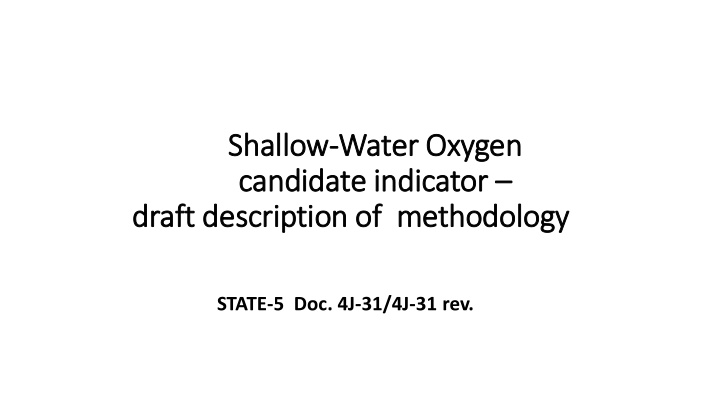



Shallow-Water O Oxygen candidate i indicator r – draft descri ription o of meth thodology STATE-5 Doc. 4J-31/4J-31 rev.
Backg kground: HELCOM Core indicator for oxygen (oxygen debt) only applicable to deep basins No common oxygen indicator in sub-basins like Gulf of Riga, Quark and in the western Baltic (Arkona Sea, Danish Straits, Kattegat) But: near-bottom oxygen concentrations measured in many Contracting Parties, in some already used for classification of degree of hypoxia or for assessing GES – this was a start
Indica cato tor Concep cept modification of Swedish WFD method („oxygen balance“) define the stratification type of each of the monitoring stations: a) well-mixed (usually: oxygenated near-bottom waters) b) seasonal stratification (often with lowered oxygen concentrations in late summer/autumn) c) stratified with perennial oxygen deficiency (longer than only in summer/autumn, residence time of water about <1 year) d) (semi)permanent stratification with long-lasting hypoxia/ anoxia (residence time >>1 year) - see table 2 in Doc. 4J-31/4J-31rev.1 for details -
Indica cato tor Concep cept define type-specific GES-targets (near-bottom oxygen concentra- tions; areal extent would be too difficult for the time being) assess the status of the monitoring stations, e.g. based on seasonal minimum aggregate the results on sub-basin level and produce map with results (see HOLAS example) basically a straight-forward method for open-sea areas (could also be used in coastal waters, e.g. if no national WFD boundaries exist)
What needs to be done Contracting Parties to assign the stratification type to their stations monitoring stations should be representative of the hydrological characteristics of the area/sub-basin to be assessed) CPs to make sure that their monitoring covers the critical season properly (late summer/autumn) IN-Eutrophication to continue work on - developing a common definiton of hypoxia as different concepts are in use - elaborating type-specific GES values - aggregation of results on sub-basin level (weighted average etc.)
Swedish waters coastal: German Target open Danish waters Arkona Sea: type-specific, >3.5 ml/l (5 sea: coastal: never No target yet mg/l) if well-mixed, >4 / >6 mg/l <2 mg/l, <4 mg/l (HELCOM) >2.1 ml/l (3 mg/l) if (stratified / well-mixed) only short-time. seasonally stratified; MSFD: 2 mg/l MSFD: 3.5 ml/l (5 mg/l) ( thresholds for hypoxia evaluation ) Bornholm Basin: Type-specific GES values 4,69 mg/l oxygen debt (HELCOM) still under development, aggregation of results still Depth of 15m as proxy under development Polish waters: from stratification >=4,2 mg/l (coastal), >5.7 mg/l (4.0 cm 3 /dm 3 MSFD)
Requ quests to the me meet eting to con consider the indicator approach, to support t the i indicator i in g general al with the aim of making it operational for use in HOLAS II, agree t to e endorse se t the f final al p proposal sals s on the indicator and its GES boundaries intersessi ssional ally.
Recommend
More recommend